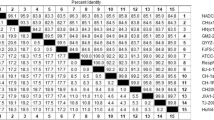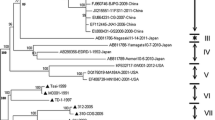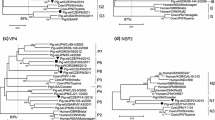Abstract
We determined the complete nucleotide sequence of EDRD-1, a Japanese strain of the North American type-Porcine reproductive and respiratory syndrome virus (PRRSV), and identified a novel 117-base deletion and 108-base insertion previously reported in the nsp2 gene of the SP strain, which contains the largest genome among PRRSV strains. Based on genetic analysis of the partial nsp2 gene in 30 additional Japanese isolates and 50 strains from various countries, we classified North American-type PRRSVs into three nsp2-types, represented by EDRD-1, which contains the 117-base deletion and 108-base insertion; prototypic VR-2332, which does not contain the deletion and insertion; and SP, which contains only the 108-base insertion. The three nsp2-types were phylogenetically separated, suggesting that these structural changes only occurred at earlier stages of viral evolution. In the nsp2 genes, we identified an additional 19 deletions ranging from 3 to 378 bases and 2 insertions of 3 and 21 bases which were not common within each nsp2-type, suggesting that these changes occurred at later stages of viral evolution. In addition, our results suggest that the three nsp2-types can be rapidly differentiated by RT-PCR using their polymorphisms as natural tags.




Similar content being viewed by others
References
Allende R, Lewis TL, Lu Z, Rock DL, Kutish GF, Ali A, Doster AR, Osorio FA (1999) North American and European porcine reproductive and respiratory syndrome viruses differ in non-structural protein coding regions. J Gen Virol 80:307–315
Benfield DA, Collins JE, Dee SE, Halbur PG, Joo HS, Lager KM, Mengeling WL, Murtaugh MP, Rossow K, Stevenson GW, Zimmerman JJ (1999) Porcine reproductive and respiratory syndrome, 8th edn. Iowa State Press, Iowa
Cavanagh D (1997) Nidovirales: a new order comprising Coronaviridae and Arteriviridae. Arch Virol 142:629–633
de Lima M, Pattnaik AK, Flores EF, Osorio FA (2006) Serologic marker candidates identified among B-cell linear epitopes of Nsp2 and structural proteins of a North American strain of porcine reproductive and respiratory syndrome virus. Virology 353:410–421
Dea S, Gagnon CA, Mardassi H, Pirzadeh B, Rogan D (2000) Current knowledge on the structural proteins of porcine reproductive and respiratory syndrome (PRRS) virus: comparison of the North American and European isolates. Arch Virol 145:659–688
Fang Y, Kim DY, Ropp S, Steen P, Christopher-Hennings J, Nelson EA, Rowland RR (2004) Heterogeneity in Nsp2 of European-like porcine reproductive and respiratory syndrome viruses isolated in the United States. Virus Res 100:229–235
Fang Y, Schneider P, Zhang WP, Faaberg KS, Nelson EA, Rowland RR (2007) Diversity and evolution of a newly emerged North American Type 1 porcine arterivirus: analysis of isolates collected between 1999 and 2004. Arch Virol 152:1009–1017
Forsberg R, Oleksiewicz MB, Petersen AM, Hein J, Botner A, Storgaard T (2001) A molecular clock dates the common ancestor of European-type porcine reproductive and respiratory syndrome virus at more than 10 years before the emergence of disease. Virology 289:174–179
Forsberg R, Storgaard T, Nielsen HS, Oleksiewicz MB, Cordioli P, Sala G, Hein J, Botner A (2002) The genetic diversity of European type PRRSV is similar to that of the North American type but is geographically skewed within Europe. Virology 299:38–47
Forsberg R (2005) Divergence time of porcine reproductive and respiratory syndrome virus subtypes. Mol Biol Evol 22:2131–2134
Gao ZQ, Guo X, Yang HC (2004) Genomic characterization of two Chinese isolates of porcine respiratory and reproductive syndrome virus. Arch Virol 149:1341–1351
Goldberg TL, Hahn EC, Weigel RM, Scherba G (2000) Genetic, geographical and temporal variation of porcine reproductive and respiratory syndrome virus in Illinois. J Gen Virol 81:171–179
Han J, Wang Y, Faaberg KS (2006) Complete genome analysis of RFLP 184 isolates of porcine reproductive and respiratory syndrome virus. Virus Res 122:175–182
Han J, Liu G, Wang Y, Faaberg KS (2007) Identification of nonessential regions of the nsp2 replicase protein of porcine reproductive and respiratory syndrome virus strain VR-2332 for replication in cell culture. J Virol 81:9878–9890
Hanada K, Suzuki Y, Nakane T, Hirose O, Gojobori T (2005) The origin and evolution of porcine reproductive and respiratory syndrome viruses. Mol Biol Evol 22:1024–1031
Kapur V, Elam MR, Pawlovich TM, Murtaugh MP (1996) Genetic variation in porcine reproductive and respiratory syndrome virus isolates in the midwestern United States. J Gen Virol 77:1271–1276
Keffaber KK (1989) Reproductive failure of unknown etiology. Am Assoc Swine Pract Newsl 1:1–9
Kim DY, Calvert JG, Chang KO, Horlen K, Kerrigan M, Rowland RR (2007) Expression and stability of foreign tags inserted into nsp2 of porcine reproductive and respiratory syndrome virus (PRRSV). Virus Res 128:106–114
Kim HS, Kwang J, Yoon IJ, Joo HS, Frey ML (1993) Enhanced replication of porcine reproductive and respiratory syndrome (PRRS) virus in a homogeneous subpopulation of MA-104 cell line. Arch Virol 133:477–483
Kuwahara H, Nunoya T, Tajima M, Kato A, Samejima T (1994) An outbreak of porcine reproductive and respiratory syndrome in Japan. J Vet Med Sci 56:901–909
Labarque G, Van Reeth K, Nauwynck H, Drexler C, Van Gucht S, Pensaert M (2004) Impact of genetic diversity of European-type porcine reproductive and respiratory syndrome virus strains on vaccine efficacy. Vaccine 22:4183–4190
Li Y, Wang X, Bo K, Tang B, Yang B, Jiang W, Jiang P (2007) Emergence of a highly pathogenic porcine reproductive and respiratory syndrome virus in the Mid-Eastern region of China. Vet J 174:577–584
Mateu E, Martin M, Vidal D (2003) Genetic diversity and phylogenetic analysis of glycoprotein 5 of European-type porcine reproductive and respiratory virus strains in Spain. J Gen Virol 84:529–534
Mengeling WL, Lager KM, Vorwald AC (1995) Diagnosis of porcine reproductive and respiratory syndrome. J Vet Diagn Invest 7:3–16
Meulenberg JJ, Hulst MM, de Meijer EJ, Moonen PL, den Besten A, de Kluyver EP, Wensvoort G, Moormann RJ (1993) Lelystad virus, the causative agent of porcine endemic abortion and respiratory syndrome (PEARS), is related to LDV and EAV. Virology 192:62–72
Murakami Y, Kato A, Tsuda T, Morozumi T, Miura Y, Sugimura T (1994) Isolation and serological characterization of porcine reproductive and respiratory syndrome (PRRS) viruses from pigs with reproductive and respiratory disorders in Japan. J Vet Med Sci 56:891–894
Nelsen CJ, Murtaugh MP, Faaberg KS (1999) Porcine reproductive and respiratory syndrome virus comparison: divergent evolution on two continents. J Virol 73:270–280
Nielsen HS, Oleksiewicz MB, Forsberg R, Stadejek T, Botner A, Storgaard T (2001) Reversion of a live porcine reproductive and respiratory syndrome virus vaccine investigated by parallel mutations. J Gen Virol 82:1263–1272
Oleksiewicz MB, Botner A, Toft P, Normann P, Storgaard T (2001) Epitope mapping porcine reproductive and respiratory syndrome virus by phage display: the nsp2 fragment of the replicase polyprotein contains a cluster of B-cell epitopes. J Virol 75:3277–3290
Opriessnig T, Pallares FJ, Nilubol D, Vincent AL, Thacker EL, Vaughn EM, Roof M, Halbur PG (2005) Genomic homology of ORF 5 gene sequence between modified live vaccine virus and porcine reproductive and respiratory syndrome virus challenge isolates is not predictive of vaccine efficacy. J Swine Health Prod 13(5):246–253
Parvin JD, Wang LH (1984) Mechanisms for the generation of src-deletion mutants and recovered sarcoma viruses: identification of viral sequences involved in src deletions and in recombination with c-src sequences. Virology 138:236–245
Paton DJ, Brown IH, Edwards S, Wensvoort G (1991) ‘Blue ear’ disease of pigs. Vet Rec 128:617
Pedersen KW, van der Meer Y, Roos N, Snijder EJ (1999) Open reading frame 1a-encoded subunits of the arterivirus replicase induce endoplasmic reticulum-derived double-membrane vesicles which carry the viral replication complex. J Virol 73:2016–2026
Ropp SL, Wees CE, Fang Y, Nelson EA, Rossow KD, Bien M, Arndt B, Preszler S, Steen P, Christopher-Hennings J, Collins JE, Benfield DA, Faaberg KS (2004) Characterization of emerging European-like porcine reproductive and respiratory syndrome virus isolates in the United States. J Virol 78:3684–3703
Shen S, Kwang J, Liu W, Liu DX (2000) Determination of the complete nucleotide sequence of a vaccine strain of porcine reproductive and respiratory syndrome virus and identification of the Nsp2 gene with a unique insertion. Arch Virol 145:871–883
Snijder EJ, Meulenberg JJ (1998) The molecular biology of arteriviruses. J Gen Virol 79:961–979
Snijder EJ, van Tol H, Roos N, Pedersen KW (2001) Non-structural proteins 2 and 3 interact to modify host cell membranes during the formation of the arterivirus replication complex. J Gen Virol 82:985–994
Snijder EJ, Brinton MA, Faaberg KS, Godeny EK, Gorbalenya AE, MacLachlan NJ, Mengeling WL, Plagemann PG (2005) Family Arteriviridae. Elsevier Academic Press, California
Stadejek T, Oleksiewicz MB, Potapchuk D, Podgorska K (2006) Porcine reproductive and respiratory syndrome virus strains of exceptional diversity in eastern Europe support the definition of new genetic subtypes. J Gen Virol 87:1835–1841
Tamura K, Dudley J, Nei M, Kumar S (2007) MEGA4: Molecular Evolutionary Genetics Analysis (MEGA) software version 4.0. Mol Biol Evol 24:1596–1599
Tian K, Yu X, Zhao T, Feng Y, Cao Z, Wang C, Hu Y, Chen X, Hu D, Tian X, Liu D, Zhang S, Deng X, Ding Y, Yang L, Zhang Y, Xiao H, Qiao M, Wang B, Hou L, Wang X, Yang X, Kang L, Sun M, Jin P, Wang S, Kitamura Y, Yan J, Gao GF (2007) Emergence of fatal PRRSV variants: unparalleled outbreaks of atypical PRRS in China and molecular dissection of the unique hallmark. PLoS ONE 2:e526
Wensvoort G, Terpstra C, Pol JM, ter Laak EA, Bloemraad M, de Kluyver EP, Kragten C, van Buiten L, den Besten A, Fea Wagenaar (1991) Mystery swine disease in The Netherlands: the isolation of Lelystad virus. Vet Q 13:121–130
Wu WH, Fang Y, Farwell R, Steffen-Bien M, Rowland RR, Christopher-Hennings J, Nelson EA (2001) A 10-kDa structural protein of porcine reproductive and respiratory syndrome virus encoded by ORF2b. Virology 287:183–191
Yan Y, Guo X, Ge X, Chen Y, Cha Z, Yang H (2007) Monoclonal antibody and porcine antisera recognized B-cell epitopes of Nsp2 protein of a Chinese strain of porcine reproductive and respiratory syndrome virus. Virus Res 126:207–215
Yoshii M, Kaku Y, Murakami Y, Shimizu M, Kato K, Ikeda H (2005) Genetic variation and geographic distribution of porcine reproductive and respiratory syndrome virus in Japan. Arch Virol 150:2313–2324
Ziebuhr J, Snijder EJ, Gorbalenya AE (2000) Virus-encoded proteinases and proteolytic processing in the Nidovirales. J Gen Virol 81:853–879
Acknowledgments
We thank Dr. H. Kuwahara, Nippon Institute for Biological Science, and Dr. T. Saito, Tochigi Livestock Hygiene Service Center, for providing Japanese isolates Gu922 M and Jtg1, respectively. We also thank Dr. Y. Murakami, National Institute of Animal Health, for providing the EDRD-1 strain and the lung homogenate from which it had been isolated. We also thank Dr. Y. Kaku, National Institute of Health, and Dr. T. Sekizaki, Dr. M. Osaki, and Dr. I. Yamane, National Institute of Animal Health, and Dr. K. Tamura, Tokyo Metropolitan University, and Dr. N. Saito, National Institute of Genetics, for their helpful suggestion.
Author information
Authors and Affiliations
Corresponding author
Additional information
The GenBank/EMBL/DDBJ accession numbers of the sequences reported in this paper are AB288110–AB288139 and AB288356.
Electronic supplementary material
Below is the link to the electronic supplementary material.
705_2008_98_MOESM1_ESM.ppt
Amino acid alignment of the three nsp2-types in nsp2. Dots and hyphens represent identical amino acids and gapped positions, respectively. B-cell epitopes identified in NVSL97-7895 [1] and BJ-4 strains [2] are underlined. Shaded areas represent positions of possible deletion ranges. a Alignment of nsp2 aa positions 423-866 (based on the SP strain) in 31 Japanese isolates and 50 strains from other countries. b Alignment of nsp2 aa 297-444 (based on the SP strain) in Jnt1 and representative strains. (PPT 62 kb).
Rights and permissions
About this article
Cite this article
Yoshii, M., Okinaga, T., Miyazaki, A. et al. Genetic polymorphism of the nsp2 gene in North American type-Porcine reproductive and respiratory syndrome virus . Arch Virol 153, 1323–1334 (2008). https://doi.org/10.1007/s00705-008-0098-6
Received:
Accepted:
Published:
Issue Date:
DOI: https://doi.org/10.1007/s00705-008-0098-6




